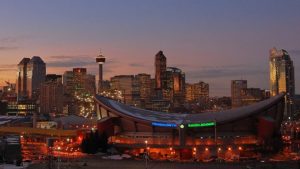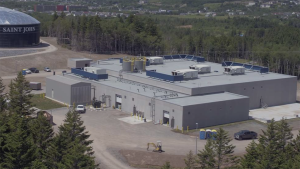Water reservoirs are usually pieces of infrastructure hidden out of sight, especially when part of large multi-use developments. But in the case of the Taza Water Reservoir on Tsuut’ina Nation land near Calgary, Alta. it’s been designed with such cultural relevance and esthetic flair it’s being highlighted as a showpiece of the new Taza Park development.
The reservoir is already servicing the Taza Park community and the Grey Eagle Resort and Casino on Tsuut’ina Nation. Designed by Zeidler Architecture with WSP and following extensive consultation with the Tsuut’ina Nation, the project features a curvilinear security fence with wooden elements suggesting a beaver dam, while the conical shape of the wooden elements recalls the shape of a teepee.
Meanwhile, inside the reservoir at the pumphouse there’s a glass facade featuring a Digital Multiplex lighting system that creates visual effects at night, reminiscent of the northern lights.
“This project was rooted in our connection with the beaver,” remarked Hal Eagletail, a knowledge keeper from Tsuut’ina Nation, in a release. “The beaver holds great significance for us as Dene people and symbolizes the history of our people as protectors of the water.”
Reservoir ‘celebrates water’
Taza Park is one of three communities planned within the broader 1,200-acre Taza development. Taza Development Corporation and its partner Canderel are intending to incorporate retail, office, rental residential, restaurant and hospitality uses. Commissioning of the reservoir serves to inaugurate the new development.
The water source for the development is the Elbow River, which flows through the Tsuut’ina Nation on its way to the Glenmore Reservoir where it gets treated. The water is then returned to Taza Park for storage in the new reservoir.

James Brown, lead architect and partner with Zeidler Architecture, explained the decision to situate the reservoir in a position of prominence stemmed from practical reasons, with proximity to the entrance of the development being the least expensive option.
“So that triggered, why not celebrate the water? This is important to First Nations communities across Canada,” Brown said, noting the team realized the project was an opportunity to “reimagine infrastructure as an element of cultural significance.”
During a site visit, the team came across a beaver dam and another light went on.
“It just triggered, this is exactly what the beaver dam does, right? It holds water. It’s directly connected to the culture. So that whole spiral and the use of wood…became the main theme, and then while we’re doing that, one of the other key features of that whole project was moving towards zero energy.”
Early on, Brown and his team spent time on the site undertaking physical mock-ups, testing various configurations of logs, lighting and integrated metal to achieve sculptural quality. They tried round poles and logs that were split but were not getting the look they wanted, he said.
Chainsaw does the trick
Finally, the team used a chainsaw, creating ledges with shadows and textures, and blue elements were added to match some of the traditional colours of Tsuut’ina regalia and give the project “vibrancy.”
“Really, it was through the mock-up process, we kind of developed it and understood how to build it and what would make the best kind of design…to create a strong visual presence,” said Brown.
Wood is also a significant component of the pumphouse. Wood was sourced locally and from B.C., in glulam and timber forms.
Just as with a beaver dam, with wood of different origins, the fencing can be replaced organically.

“Our expectation is, as the project ages, there’ll be potentially poles replaced or they might be damaged,” Brown said. “And that can easily be done by the community themselves, just literally by finding a tree in the forest and attaching it.”
The design is targeting net-zero emissions, aligned with the sustainability framework created for all public buildings within Tsuut’ina Nation. Solar will supply the majority of the pumphouse’s electrical requirements.
The reservoir itself is just a typical concrete structure, similar to any other, Brown said. It has a total capacity of 6,700 cubic metres of water, capable of providing a reliable water source for more than 15,000 residents.
The reservoir project is essentially complete, Brown said, with minor finishing elements and landscaping to continue in the coming months.
Follow the author on X/Twitter @DonWall_DCN.











Recent Comments